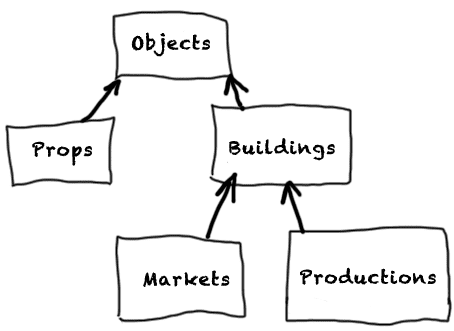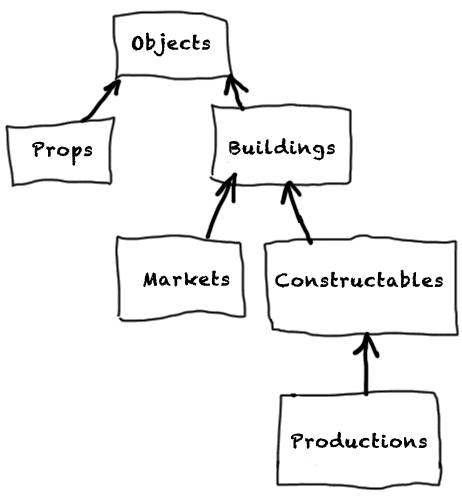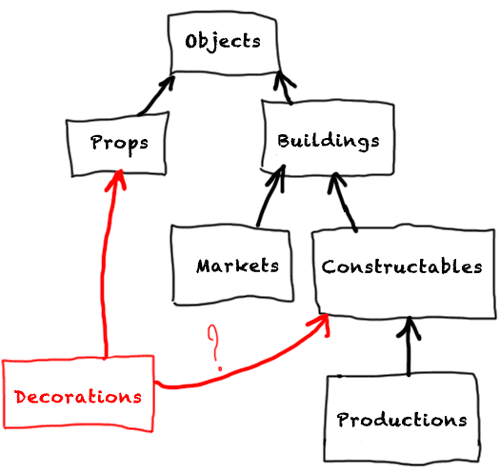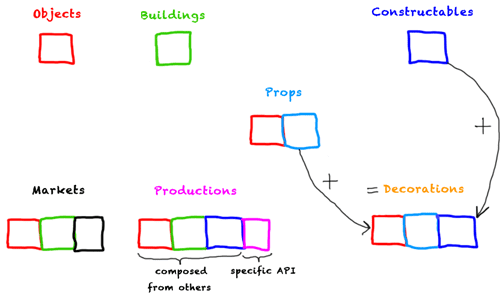Inheritance, composition and Backbone.js
☕☕ 9 min read
“Favor objects composition over inheritance”
When you’re doing Object Oriented Programmation (OOP), you create a bunch of objects with their data structure and methods that compose their interface. You decide how to split your objects based on the Single Responsibility Principle (SRP): each object should have one and only one reason to change.
To make interesting stuff happen, you need to combine those objects.
Roughly, there are 2 types of relationships in an object model: inheritance and composition.
You can do the analogy with a family tree:
- inheritance is like a birth: when it happens, this is for life.
- composition is like a marriage: it happens during the participating objects’ lifetimes, and it can change. Objects can discard partners and get new partners to collaborate with. Please note that objects are surely not monogams.
Source: Object Design - Roles, Responsibilities and Collaborations
“Inheritance” all the things!
The very first thing JavaScript developers do is trying to mimic rules of pseudo-classical inheritance.
They usually quickly come up with a lot of new everywhere and inheritance chains awfully long. That generally produce something very hard to maintain.
That’s true you’ve got everything you need to do inheritance with classes, interfaces, … in Java.
This is not JavaScript.
Keep It Simple, Seriously
The base rule in JavaScript is prototypal inheritance.
Forget about the technical jargon, just remember you have objects that can link to other objects (OLOO).
Thus, it’s way simpler to encapsulate methods from a same logic into an object, then simply return this object. If you need to, you can also create a function that will return an object — which is what we call a factory.
Then you’ll take this object, eventually compose it with others, to build the prototype which you’ll use to instantiate your class. That simple.
To sum it up: instead of creating huge, poorly built, inheritance chains from constructors, simply create your objects and compose them to create a prototype you will instantiate your class with.
Concatenative inheritance
Someone notified me that what I’m talking about here is called multiple inheritance, not actual object composition.
When you do object composition, you make attributes point to instances of other classes.
There is no multiple inheritance in JavaScript. Still, composing different prototypes to produce a totally new one is a very close notion, which can be confusing. Here we are talking about “composing prototypes”, but not in the terms of objects composition…
There you’ll find a more concrete explanation: Composition, Inheritance, and Aggregation in JavaScript
So, let’s call that concatenative inheritance, as detailed by Eric Eliott.
With a concrete example
Context
For quite some time I’ve been working full-time on Vinoga, a social-farming game about wine, developed in HTML5.
Among few libraries, we use Backbone.js to decouple our views from our data with ease.
Let’s take a concrete use case: elements on the map.
If we take a few time to think about it, there are actually 2 types of elements:
Propsthat are decorations elements — trees, rocks, paths…Buildingsthat are buildings of the game — winery, castle…
There is, among others, one difference we can notice from now: Buildings can be constructed — from the build menu —, not Props since they already are on the map.
Whatever, all these elements share a common behavior: they are on the map. Hence, Props and Buildings both inherit from Objects, which describes the behavior of an “object” on the map.
But there also are different types of Buildings, such as:
Marketsthat are buildings that will reflect the state of the player’s storeProductionsbuildings, that will transform resources — grape, juice — into another product — juice, bottle.

About constructability
After we discussed with the Game Designer, we realized that Markets are not constructable: they already are on the map.
Constructability is a behavior that were part of the Buildings one until now. But yep, let’s handle that with a little modification of the inheritance chain:

Here comes the drama
As time goes, specs evolve and features too: brace yourself, Decorations are coming!
Decorations are decorations elements — actually, Props — except that they are constructables too!
Well, now we’re a bit stucked since ConstructableBuildings inherits from Buildings. We’d like not to duplicate ConstructableBuildings to recode roughly the same thing into Props.
Looks like we’ll end up with classes that inherit of useless properties at the very best.

Why so pseudo-classical?
Well, how did we get there? How to get out of here?
Actually, we were a bit in the hurry when the constructability question appears. Without any more reflexion we came with the logic that ”Productions IS a ConstructableBuildings that IS a Buildings that IS an Objects”. Kaboom, inheritance!
In fact, if we look closer, we could infer that constructability is a behavior. You can not say that there is no Constructable element without Building. This is a subtle error that is so frequent in JavaScript because of pseudo-classical inheritance since this is the only thing you remember: this is the very first — bad — instinct.
In our case, the only legitimate inheritance chain may be the one that bounds Decorations to Props. Anyway, I still think that you can get rid of it too.
What you actually put into Objects is a bunch of behaviors that are shared between Props and Buildings. But technically, Objects doesn’t represent anything concrete: this would be an abstract class if we were coding in Java. Just like Buildings by the way.
Embrace composition
In JavaScript, may I suggest another way: let’s describe each behavior into its own object. Let’s get rid of constructors and inheritance chains.
Then, combine these objects to make the prototype of objects we want to build. No class around, simply objects that are composed from other objects. Eventually factories to construct the correct object regarding your needs.

Here we just augment our prototype with other objects that describe behaviors. That’s what mixin is about.
If your object inherits from another, then prefer to use prototypal inheritance.
What about Backbone?
Backbone.extend
When you use Backbone, you use .extend() to override Backbone.[Model|Collection|View|…]. Then you instantiate it with new.
Thus, it’s very frequent to follow the pseudo-classical inheritance reflex and to end up with:
var ObjectsModel = Backbone.Model.extend( … );
var BuildingsModel = ObjectsModel.extend( … );
var MarketsModel = BuildingsModel.extend( … );Which, by the way, would be the same than:
var MarketsModel = Backbone.Model.extend(…).extend(…).extend(…);
// Then you instantiate when needed
var marketsModel = new MarketsModel();Backbone is built like that. .extend() easily lead us to that slippery slope where Models depend on the others in many not-that-subtle ways.
Compose your prototype THEN extend
Even though you need to inherit from Backbone, you can at least limit the damages. Even though .extend() exists, you don’t have to use it for every single object you create. The only object we really need to .extend() here is Backbone.Model.
The main idea is to compose objects to make to prototype you will then use into the .extend() of your Model / Collection / View…
var objectsModelProto = {
/* … */
}
var buildingsModelProto = {
/* … */
}
var constructablesModelProto = {
/* … */
}
// We compose to make a new prototype.
var marketsModelProto = _.assign(
{
/* … */
}, // -> specific interface for markets
objectsModelProto, //
buildingsModelProto, // => our mixins
constructablesModelProto, //
{
/* … */
} // -> to override mixins, if needed
)
// Once prototype is created, inherit from Backbone.
var MarketsModel = Backbone.Model.extend(marketsModelProto)
// Then you instantiate.
var marketsModel = new MarketsModel()You can see how objectsModelProto, buildingsModelProto and constructablesModelProto override the base prototype of marketsModelProto to add specific behaviors.
Merge or assign
Please note that might be useful to use _.merge instead of _.assign if you need to merge attributes deeply. This may be handy with Backbone when you need to merge things like events:
var objectsViewProto = {
events: {
'click .store': 'store',
'click .turn': 'turn',
},
store: function store() {
/* … */
},
turn: function turn() {
/* … */
},
}
_.assign(
{
displayModal: function displayModal() {
/* … */
},
select: function select() {
/* … */
},
},
objectsViewProto,
{
events: {
click: 'select',
'click .turn': 'displayModal',
},
}
)
// ->
// {
// events: {
// "click": "select",
// "click .turn": "displayModal"
// },
//
// displayModal: function displayModal () { /* … */ },
// select: function select () { /* … */ },
// store: function store () { /* … */ },
// turn: function turn () { /* … */ }
// }
_.merge(
{
displayModal: function displayModal() {
/* … */
},
select: function select() {
/* … */
},
},
objectsViewProto,
{
events: {
click: 'select',
'click .turn': 'displayModal',
},
}
)
// ->
// {
// events: {
// "click": "select",
// "click .store": "store",
// "click .turn": "displayModal"
// },
//
// displayModal: function displayModal () { /* … */ },
// select: function select () { /* … */ },
// store: function store () { /* … */ },
// turn: function turn () { /* … */ }
// }In conclusion
Favor objects composition over inheritance. Don’t use inheritance if it doesn’t really make sense, or is required. Beware overlong inheritance chains: that’s damn fragile.
What is preferable to avoid:
// markets.model.js
var MarketsModel = ConstructablesModel.extend({
/* … */
})
// main.js
var marketsModel = new MarketsModel()Far more flexible, simpler:
// markets.model.js
var marketsModelProto = _.assign(
{
/* … */
}, // -> specific interface of markets
objectsModelProto,
buildingsModelProto,
constructablesModelProto
)
// main.js
var MarketsModel = Backbone.Model.extend(marketsModelProto)
var marketsModel = new MarketsModel()Let’s end up this post with few post I recommend you to read if you need to know more about composition and inheritance with JavaScript:
- Understanding Prototypes, Delegation & Composition > an explanation from A to Z which is simple, clear and illustrated
- Common Misconceptions about Inheritance in Javascript > detailed FAQ that goes deep on this subject